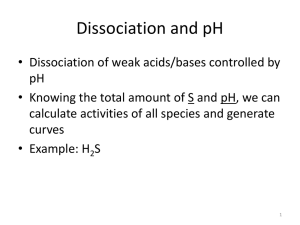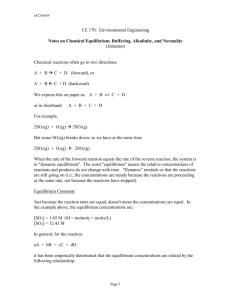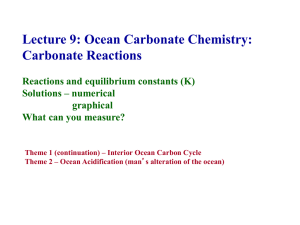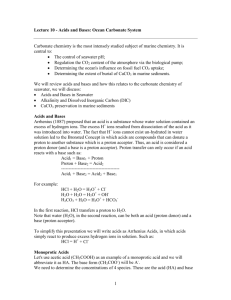CO 3 2
advertisement
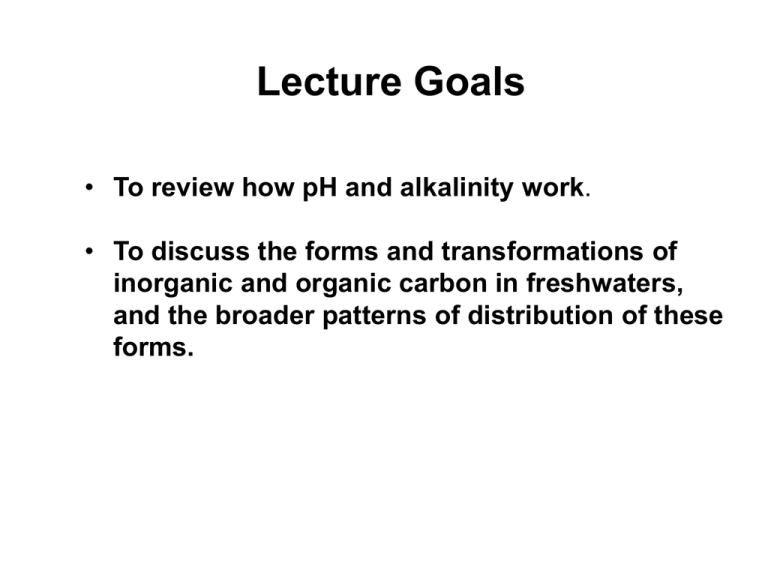
Lecture Goals • To review how pH and alkalinity work. • To discuss the forms and transformations of inorganic and organic carbon in freshwaters, and the broader patterns of distribution of these forms. What is pH? • “Puissance d’hydrogene”, where hydrogen = H+ • Low pH = acidic = high concentration of H+ • pH ranges from < 1 to 14 on logarithmic scale, so unit change represents 10x change in concentration of H+ What is alkalinity? • Acid-neutralizing capacity (ANC) of water, or the ability to offset the positive charges of H+ cations with negatively charged anions • Determined by the concentration of bases: HCO3-, CO32-, OH• High ANC = small change in pH with addition of a strong acid (i.e., well-buffered) • At neutrality (pH = 7), then activity of H+ and HCO3-, CO32-, OH- are equal Where does alkalinity come from? • The bicarbonate buffer system • Weathering CaCO3 +H2O + CO2 ↔ Ca2+ + 2HCO3• CO2 from atmosphere, H2O from rain, CaCO3 in rocks • Ca2+ and HCO3- carried to streams, rivers, lakes, oceans Why are pH and alkalinity like cars in a parking lot, not like married couples? YES! NO Inorganic C in freshwaters • Buffers water against rapid changes in pH via bicarbonate buffer system • Determines how much C available for photosynthesis and generation of organic substances (i.e., foundation of organic productivity) • Contributes to overall conductivity of water = concentration of ions that influence physiological processes in biota Carbon Dioxide CO2 • Expected to be at equilibrium with atmosphere – 200x more soluble than O2 • 0.037% of atmosphere, and low partial pressure, but increasing • Many lakes are supersaturated with CO2 DIC and pH The bicarbonate buffer system CO2 + H2O ↔ H2CO3 ↔ H+ + HCO3- ↔ 2H+ + CO32- pH • Determines the predominant form of DIC in freshwater systems. The players: Carbonic Acid CO2 + H2O ↔ H2CO3 Weak Acid The players: Bicarbonate H2CO3 ↔ + H + HCO3 • Dissociation declines with decreasing pH • When substrate rich in carbonates (CO32-): CaCO3 +H2O + CO2 ↔ Ca2+ + 2HCO3- The players: Carbonate HCO3 ↔ + 2H + 2CO3 • This only happens when pH very high • CO32- is relatively insoluble and will precipitate out when Ca2+ available in water or substrate The Whole Cycle CO2 + H2O ↔ H2CO3 ↔ H+ + HCO3- ↔ 2H+ + CO32-*** *** If Ca2+ available, then combines with CO32- to form CaCO3, which precipitates out. The bicarbonate buffer system CO2 + H2O ↔ H2CO3 ↔ H+ + HCO3- ↔ 2H+ + CO32- pH • Determines the predominant form of DIC in freshwater systems. The bicarbonate buffer system CO2 + H2O ↔ H2CO3 ↔ H+ + HCO3- ↔ 2H+ + CO32CO2 + H2O Background pH? H2CO3 H+ + HCO32H+ + CO32- • Buffers water against rapid changes in pH H+ or CO2 CO2 + H2O ↔ H2CO3 pH • Buffers water against rapid changes in pH…or not. H+ or CO2 CO2 + H2O ↔ H2CO3 ↔ H+ + HCO3- ↔ 2H+ + CO32- No change in pH! • Buffers water against rapid changes in pH…or not. The Whole Cycle CO2 + H2O ↔ H2CO3 ↔ H+ + HCO3- ↔ 2H+ + CO32-*** *** If Ca2+ available, then combines with CO32- to form CaCO3, which precipitates out. The Whole Cycle CO2 + H2O ↔ H2CO3 ↔ H+ + HCO3- ↔ 2H+ + CO32Remember that these are equilibrium reactions! CO2 + H2O ↔ H2CO3 ↔ H+ + HCO3- ↔ 2H+ + CO32- Add CO2 (e.g., respiration) CO2 + H2O ↔ H2CO3 ↔ H+ + HCO3- ↔ 2H+ + CO32- Remove CO2 (e.g., photosynthesis) Where does alkalinity come from? • The bicarbonate buffer system • Weathering CaCO3 +H2O + CO2 ↔ Ca2+ + 2HCO3• CO2 from atmosphere, H2O from rain, CaCO3 in rocks • Ca2+ and HCO3- carried to streams, rivers, lakes, oceans Carbon Sinks Forests Ocean Weathering and the Global Carbon Cycle Export of Alkalinity by the Mississippi River Effect of Land Cover on Alkalinity Export by Mississippi Sub-Basins Carbon Sinks Cropland Forests Ocean Controls on DIC distribution and concentration in freshwaters Respiration Photosynthesis How much? Where? DIC in Lakes • Equilibrium with atmospheric CO2…or > • Bicarbonate buffer system • External loading (i.e., input from groundwater and rivers) • Respiration – Photosynthesis balance Vertical Distribution of DIC in Lakes DIC in Rivers • Decomposition dominates over photosynthesis, so tend to produce CO2 rather than consuming - Respiration can be so high that CO2 is maintained above equilibrium • Inflowing water high in CO2 from bacterial respiration • High turbulence causes CO2 to be lost quickly, but can see high CO2 in non-turbulent areas and during low flows • Rivers and streams also act to move alkalinity (i.e., HCO3- and CO32-) to lakes or to the ocean Origins of Organic C Autochthonous Allochthonous Forms of Organic C DOC: Dissolved organic carbon POC: Particulate organic carbon (aka, POM) Function of Source + Stage of Decomposition Forms of DOC Methane CH4 Forms of DOC Stable Organic Acids aka Humic Acids Blackwater Streams POC Patterns Headwaters → allochthonous CPOC, low autochthonous OC POC Patterns Rivers → allochthonous FPOC, higher autochthonous OC How much of each source? Autochthonous Allochthonous Determining C sources with stable isotopes • Isotopes: forms of elements with different numbers of neutrons • 13C / 12C = 13C • 13C values often differ between aquatic and terrestrial primary producers: 13C Algae > 13C Terrestrial Plants • Therefore, 13C signal in consumers can tell you where they are getting their C Determining C sources with stable isotopes = Low 13C = High 13C Determining C sources with stable isotopes…a big improvement! McCutchan and Lewis 2002 • In Colorado headwaters, autochthonous C accounted for <2-40% of total organic matter. • However, autochthonous C accounted 40-80% of invertebrate biomass…WHY? Autochthonous Allochthonous
